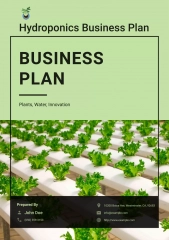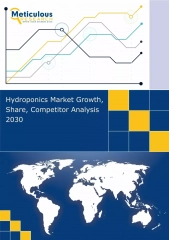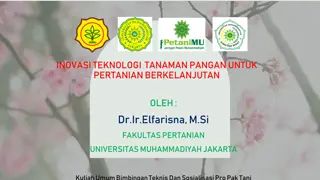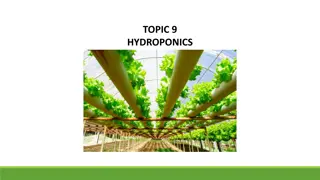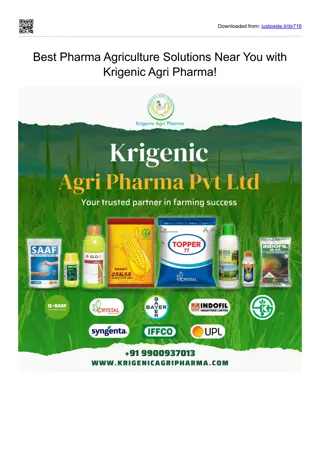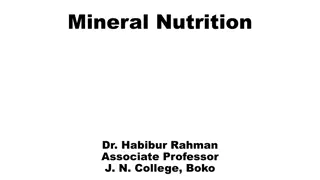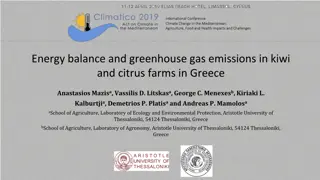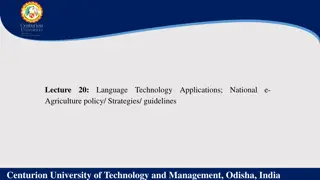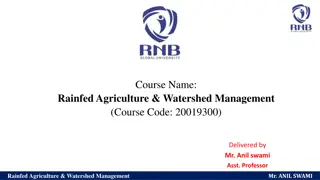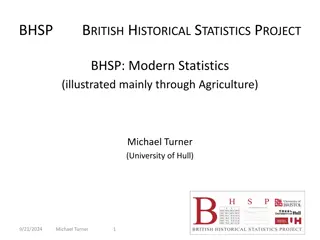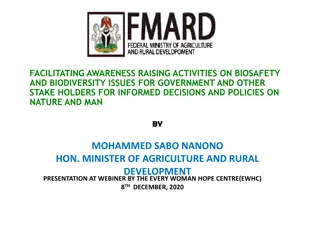Revolutionizing Agriculture: The Hydroponics Solution
Hydroponics offers a sustainable method of plant cultivation without soil, addressing challenges like soil degradation, water scarcity, and climate change. By using nutrient-rich water, oxygen, and light, plants can thrive faster and more efficiently compared to traditional soil-based methods. Various types of hydroponic farming systems enable efficient plant growth while conserving water resources and minimizing the impact of climate change on crop production.
Download Presentation

Please find below an Image/Link to download the presentation.
The content on the website is provided AS IS for your information and personal use only. It may not be sold, licensed, or shared on other websites without obtaining consent from the author.If you encounter any issues during the download, it is possible that the publisher has removed the file from their server.
You are allowed to download the files provided on this website for personal or commercial use, subject to the condition that they are used lawfully. All files are the property of their respective owners.
The content on the website is provided AS IS for your information and personal use only. It may not be sold, licensed, or shared on other websites without obtaining consent from the author.
E N D
Presentation Transcript
Hydroponics: Gardening Without Soil BY HAMSIKA CHANDRAMOULI CALGARY GIRLS CHARTER SCHOOL
HYPOTHESIS Can nutrient-rich water, Oxygen and light sustain thriving plant life without soil? Will plants grow faster in water than in soil?
What is Hydroponics? Soil erosion, land degradation and many other issues are impacting the land so is there a way to grow plants without soil?! Yes! Hydroponics! Hydroponics is a method of growing plants without soil, using water, nutrients, and light. Plant has to sprout a few leaves in a container containing soil or coir. They are placed in the Hydroponics system after the plant has at least 4 leaves
Types of Hydroponic Farming Nutrient Film Technique Deep Water Culture (DWC) Wick System Ebb and Flow Drip System Aeroponics
Why Use Hydroponics? Helps overcome the challenges of soil degradation, water scarcity, and climate change Hydroponics is a soil-less method of growing plants It can help us address some of the major challenges that face our food system Soil Degradation: Conventional farming practices have depleted the soil of its nutrients and organic matter which makes the soil less fertile and more prone to erosion Hydroponics does not use soil, so it avoids this problem It can grow food in areas where soil is scarce or unsuitable
Why Use Hydroponics? Water Scarcity: Water is a precious and limited resource that is essential for life Agriculture accounts for about withdrawals Much of it is wasted due to inefficient irrigation, evaporation, and runoff Hydroponics uses up to 90% less water than soil-based farming It recycles and reuses the water in a closed-loop system 70% of global freshwater
Why Use Hydroponics? Climate Change and Crop Impact: Climate change temperatures. Extreme events (droughts, floods, heat waves, storms) harm crops. Result: Reduced food security. Hydroponics allows indoor production. Less vulnerable to climate variability. Enables year-round crop growth. affects weather patterns, seasons, and or controlled environment food
Hydroponics What Crops Can You Grow Many crops can be grown using Hydroponics. The most popular cucumbers, watercress, celery, and some types of herbs. The plants that don t grow in hydroponics are Plants that need to spread and climb; such as vines and trees Plants that are root crops; such as potatoes, carrots and onions. are leaf lettuce, tomatoes, peppers,
Advantages of Hydroponics No Soil Needed Land Degradation in Traditional Farming: One of the primary challenges in traditional farming is land degradation. Land degradation occurs due to two main factors: Physical degradation - related to natural erosion. Chemical degradation - results from pollution or contamination. Effects of Soil Breakdown: As the soil breaks down and degrades, it becomes difficult for farming. There are fewer nutrients available for plants to thrive. Hydroponics as a Solution: Offers an excellent alternative for growing plants. In hydroponic systems, plants grow without soil, directly in nutrient-rich water. This method allows for efficient nutrient uptake and optimal growth.
Advantages of Hydroponics Can Grow Anywhere Faster Crop Growth Reduced exposure to pests, diseases, and harmful chemicals accelerates crop growth. Some plant varieties experience up to 5x faster growth with the addition of grow lights. Efficient Nutrient Usage Nutrient optimization enables plants to establish and develop more rapidly. In hydroponics, multiple plants can thrive simultaneously since roots don t compete for nutrients.
Disadvantages of Hydroponics High Cost Cost Differences by System Type: Hydroponic costs vary based on the type of system and its complexity. Different systems have different price ranges. Impact of System Size: The size of the hydroponic system significantly affects the cost. Larger systems require more materials, equipment, and space, resulting in higher expenses.
Disadvantages of Hydroponics Complexity and Maintenance: Need To Be More Technical Hydroponics requires a good understanding of the system. Regular monitoring and maintenance are essential to ensure optimal conditions for plant growth. Power Dependency: Hydroponic systems rely on electricity for pumps, lights, and other components. Power outages can disrupt the system and affect plant health. Risk of System Failures: Malfunctions or failures in pumps, timers, or nutrient delivery can harm plants.
Disadvantages of Hydroponics Nutrient Imbalance: Maintaining the right nutrient balance can be challenging. Imbalances can lead to deficiencies or toxicities in plants. Limited Crop Variety: Some crops thrive better in soil than in hydroponic systems. Certain root vegetables and large plants may not be suitable for hydroponics. Banned Crops Banned products, such as marijuana are sometimes illegally grown in hydroponics system.
Hydroponics Vs. Traditional Farming COMPARISON Traditional Farming Takes up more space Grown only in specific climates Can get diseases, weeds and pests Uses up less sunlight, more water and sometimes may use up the topsoil Soil erosion may happen Sometimes environment with pesticides and herbicides Roots have to search for nutrients Hydroponic Farming: Takes up far less space Can be grown anywhere Protected from most diseases, weeds and pests (since it is not grown in soil) Uses sunlight less and does not use up topsoil Does not pollute the environment with dangerous chemicals more, water pollutes the
MATERIALS REQUIRED Seeds for growing plants Water Recycled Container Nutrient Solution Grow Lights DC Water Pump Possibly Coconut Coir Containers with Soil Topic research using Internet
ANALYSIS What type of hydroponics should I research on? Selected DWC What plants can grow? Cabbage, tomato, leaf lettuce How are we going to start the seedlings? started in a small cup Once the seedlings grow, when are we going to transplant it in hydroponics? When 2-3 leaves have grown How fast does plants in a hydroponic system grow compared to plants in a traditional farming? Do you need grow light? 5x more faster Does spinach grow well in a hydroponics system? So far, yes
ANALYSIS How much times do we need to change the water in hydroponics? Do we need to add more? Every 2-3 weeks. Why do we need change the water in the hydroponics system? So the plants have access to the nutrients and if not removed, you have waste products in your hydroponics set. Why did one of the tomato plants became brown and why did the cabbage plant die? Because water was not recycled. Can you start/plant a crop directly from seed in a hydroponic system? No, because it will not germinate. Why did one of the tomato plant die? Because, the roots were damaged during the transplantation process.
ISSUES FACED ? One cabbage and lettuce plant died after transplanting in the hydroponic system Plants were not growing properly after 2 weeks - didn t know that water has to be changed every 2-3 weeks Other tomato plant became brown and drooped due to not recycling the water in the hydroponics system Another tomato plant died as it wasn t transplanted properly initially. Tried to germinate a seed in the hydroponics system which did not work The plants in the normal containers with soil was growing slowly than the ones in the hydroponics Spinach plants growing slower than tomato plants in the hydroponics system
Tomato Plant - Growth Rate Time after Germination Tomato Plant in Hydroponics (inches) Tomato Plant in Soil Container (inches) Week 1 2 2 Week 2 5 2.3 Week 3 7 2.5 Week 4 10.5 2.7 Week 5 11 3
CONCLUSION In conclusion, my hypothesis was correct! Along with nutrients added to water, with some grow lights, you can grow plants without soil! This is a way to prevent the topsoil being used up. Though there are some challenges for maintaining the hydroponics systems, it is a great way to grow thriving plants! My second hypothesis was also correct! According to my research, plants in a hydroponic system grow 5x more faster than plants in traditional farming.
REFERENCES Eden Green Technology - Hydroponics vs. Traditional Farming Eden Green - Advantages Of Hydroponics Wikipedia - Hydroponics Miracle Gro - What Plants Cannot Grow In Hydroponics Growee - Why Is Hydroponics Expensive AeroGarden - How Fast Does Hydroponics Farming Grow AGrowTronics - How Much Times Do We Have To Change Water In Hydroponics Growee - Why Do We Have To Change Water In Hydroponics The Hindu - All About Hydroponics
Science Fair Daily Log Oct. 23, 2023 - Today I did background research on hydroponics. I watched a lot of youtube videos to help me get in depth of the topic. I learned that there are different types of hydroponics (Nutrient Film Technique, Deep Water Culture also known as DWC , Wick System, Ebb and Flow, Drip System and Aeroponics). Hydroponics is when plants are grown in nutrient filled water. My dad and I are going to do DWC. Sites: 1.https://byjus.com/neet/hydroponic-system/ 2.https://www.youtube.com/watch?v=1PVdQ3-7UIs 3.https://www.sciencebuddies.org/science-fair-projects/project-ideas/PlantBio_p045/plant- biology/hydroponics-gardening-without-soil 4.https://www.youtube.com/watch?v=LV2jIkOwYl8 Nov. 20, 2023 - (Hydroponics) Google Doc where I upload all my information)
Science Fair Daily Log Deep Water Culture (DWC): Dec. 4 - I did some research about what hydroponics is. Hydroponics in general means growing plants in a nutrient solution without soil. But deep water culture means the plant's roots are suspended over water containing minerals and treated with oxygen. Materials: Seeds for growing plants Water Recycled Container DC Water Pump Possibly Coconut Coir Resources from the internet As I do more research more materials or resources may be needed.
Science Fair Daily Log Dec. 11- I researched about the pros and cons of hydroponics Pros: - - Can grow anywhere Places lacking things needed to grow plants (such as fertile soil), can use hydroponics Cons: - - - Increasing cost Need to have a good understanding Some people use it to grow banned products like marijuana Jan. 9, 2024 So is soil really necessary for a plant to survive, or can plants survive in just water? What if the water had all of the nutrients in it that soil does? The answer to this question is yes. Plants can survive without being planted in soil.
Science Fair Daily Log (Continued) Jan. 21 2024 - My dad and I planted the seeds (lettuce and tomato) in soil first (because we need a little bit of growth before we can move the plant to a hydroponic location). We attached some growing lights so the plants can thrive. At the end of two weeks, I noticed that the plants had sprouted and reached a height of about one and a half inches. The stems had a fuzzy layer as well as the leaves. Some of the stems were light brown. All of the plants were thriving and will soon be relocated to a hydroponic location. According to Square Mile Farms, Seedlings are too young to transplant when they have only grown their first leaves (cotyledon leaves). They must reach the 'true leaf' stage, where at least the second set of leaves have grown out. So we should wait until the lettuce and tomato have grown their first leaves. Jan. 27 - The plant that was transplanted 6 days ago grew an inch more. My dad and I observed that it grew faster than normal traditional farming. Then my dad and myself transplanted other plants into the hydroponic set because it had about 3 leaves. Then like last time we situated the grow lights above the plant for extra sunlight.
Science Fair Daily Log (Continued) Jan. 27 - Feb. 4 2024 - Over the course of a week I added some details to the slides since the rough draft is due this soon. Feb. 4, 2024 - I researched a lot today and added more slides to the advantages and disadvantages. In the hydroponics set, new leaves are starting to form. Feb. 17, 2024 - Today we recycled the water and since one of the tomato plants died, my dad and I transplanted another tomato plant into the hydroponics system. The tomato plant that we planted first was starting to droop and becoming a light tint of brown. I quickly figured out that the cause was probably because we did not recycle the water every 2-3 weeks.


